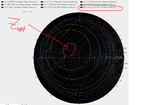natnoraa
Full Member level 1

Hi guys,
I have a question regarding load pull simulation. After obtaining the Zload for optimum power (at this point my input is not matched yet) i did the matching for output, i went on to conjugate match my input but the results were terrible with the S21 going below -5dB (supposed to be about 10dB). That happens if i did my input matching after load pull. Should i conjugate match it first before load pull simulation then? Advise please. thanks in advance!
natnoraa
I have a question regarding load pull simulation. After obtaining the Zload for optimum power (at this point my input is not matched yet) i did the matching for output, i went on to conjugate match my input but the results were terrible with the S21 going below -5dB (supposed to be about 10dB). That happens if i did my input matching after load pull. Should i conjugate match it first before load pull simulation then? Advise please. thanks in advance!
natnoraa








